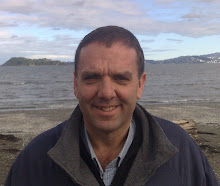
The Olympic Stadium in Sydney is a big piece of architecture, its main arch span is 295.6 metres (it could fit 4 Boeing 747’s side to side). Among it's many cunning features it has the capacity to change from a rectangle to an oval. In the weird and wonderful world that is Australian Sport this is useful, because Rugby League is played on a rectangle and Aussie Rules on an Oval. They do of course play other sports in Australia but they are not as exciting to the great Australian sporting public as these two are. Shane Warne only took up Cricket when he failed to make it in Australian Rules Football.

A whole section of the central stand on either side is mounted on runners and can be rolled forward or back. This is the kind of stuff that Uncle Jerry appreciates. When encountering something new and interesting Jerry will often cock his head slightly to one side, crack a smile and comment in a typically understated way along the lines of "That's quite something eh?"

This got me thinking what job Jerry could do at the Olympic Stadium. He could be the Chief Executive but that kind of corporate position would not resonate with his sense of call. One possibility would be being the worker who looks after the giant video screens. These are huge and very expensive. They have thousands of bulbs inside. Each in its place contributes to the big picture shown to the crowds in the stadium. Making sure each one is in the right place, is properly connected and shining is a job for Jerry.

This would involve scaling up to the gangplank for entry to the back of the screen but Jerry has always been up for a bit of adventure.

A further option would be the curator of the art and exhibits in the stadium. Many people have contributed from sporting legends like David Beckham writing his name on the wall, to memorable items being displayed (they probably have one of Jonny Wilkinson's plaster casts there - most stadiums do), to this art contributed by kids. This fostering of creativity and wanting to see everyone's contribution valued and included would resonate with Jerry.

Another option would be caring for the people. Some of the seats are sponsored with the names of those who sit there. Most churches have thankfully moved beyond pre-allocated seating but there are people here who come to all the events and some who just make occassional appearances. These seats are allocated to the Bland Family. Be it the bland family or the blind family Jerry would be interested in each one, know their name and love them despite their blandness. (even encourage them to tastiness)

Before you start thinking that the man is some kind of superman he would claim no special abilities. He is basically an ordinary minister. His priorities are the feeding, leading, loving, knowing, serving priorities of the shepherd. I am increasingly concerned by the number of ministers I talk to who who see themselves through a corporate lens. They see themselves as the CEO, the elders are the board, the congregation the shareholders and the community the customers. It steps away from the model of a shepherd to the model of a suit.

I rather like Gordon Ramsey. His language leaves a bit to be desired but he is passionate about what matters to him. He is scathing of restaurants where the food is not seen as the most important thing. The pastoral ministry is about feeding the flock. We can become too preoccupied with strategy, team building, community action, programmes and ideas that we lose the priority of feeding for and caring for the flock. I wonder what a spiritual Gordon Ramsey would make of the diet that is served up in many churches, youth groups and sunday schools?
Ministry is not a career it is a calling. Would somebody please feed the sheep.
Which is where the Gordon Ramsey analogy breaks down because I suspect that is not quite what he has in mind for the lamb thrown over his shoulder. But maybe that's the point. If we are not feeding the sheep we are killing them.
Which is why in the end the job that appealed to me most for Jerry is to be the guy who serves refreshments in one of the bars. It rather appropriately is called the "Sin Bin".












































